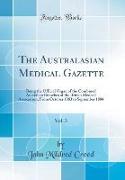- Start
- The Australasian Medical Gazette, Vol. 3
The Australasian Medical Gazette, Vol. 3
Angebote / Angebote:
Excerpt from The Australasian Medical Gazette, Vol. 3: Being the Official Organ of the Combined Australian Branches of the British Medical Association, From October 1883 to September 1884The ¿uid contained in the unripe cocoa-nuts, and peculiarity of climate, are equally assigned as the causes of its production. That it prevails to a greater extent in tropical countries than in colder climates, and in those localities which are low and in the vicinity of the sea, is well known. The increase of this disease in a great measure depends upon the strength Of the constitution of the person attacked, in some cases advancing with great rapidity, and in others after many years' duration the deformity is still very inconsiderable. The patients suffering from this disease are liable to occasional attacks of in¿amma tion of the skin, and subjacent parts, accompanied by paroxysms Of fever, closely resembling ague, and, under these circumstances, life and the disease advance together, since no native or foreign remedy has been found competent for its cure. An application of the scraped tuberous root of the pia, or South Sea arrowroot (tacca pinuatifida), has been used by the natives Of the Society. Islands to the diseased skin as a remedy. The largest scrotal tumour that came under my notice in the Southern Pacific was at the Island of Tahiti, it was accompanied by the fefe or ele phantiasis, the lower limbs being affected by that disease. The subject Of this malady was a native Of Mexico, but had been a resident on the island for twenty-eight years. He was at this time fifty years Old. The tumour first made its appearance about nine or ten years previously, in the form of a swelling on each side of the groin, which gradually °increasing in size, in descending united and formed into one mass, entirely covering the penis. The tumour gradually increasing from that time new extended to his ankles. Its weight, as far as could be ascertained, was about 961b., and the size by measurement was as follows - The length from the crest of the pubes to the base of the tumour was two feet five inches circumference of the upper portion, just below the pubes, was twenty-one inches of the centre, four feet and at the largest part, just below the urethra, four feet eight inches. For hydrocele they perio rough, but often a successful, operation. In New Zealand, and many of the Polynesian Islands, a person suffering from disease was supposed to have incurred the displeasure of the gods. Atten tion was therefore directed to the adoption of such means as would appease their anger. This was done by applying to the tohunga, or priest, who made suitable Offerings accompanied by prayers. The tohunga or priest is therefore the doctor he is well acquainted with the native medicinal.About the PublisherForgotten Books publishes hundreds of thousands of rare and classic books. Find more at www.forgottenbooks.comThis book is a reproduction of an important historical work. Forgotten Books uses state-of-the-art technology to digitally reconstruct the work, preserving the original format whilst repairing imperfections present in the aged copy. In rare cases, an imperfection in the original, such as a blemish or missing page, may be replicated in our edition. We do, however, repair the vast majority of imperfections successfully, any imperfections that remain are intentionally left to preserve the state of such historical works.
Folgt in ca. 10 Arbeitstagen
